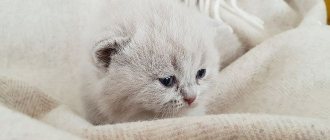Origin story
The Ural Rex first appeared - which, however, is already clear from the name - in the Urals and is an indigenous breed.
The first mentions of small cats with curly fur appeared back in the 30s, but after the Great Patriotic War their number was reduced to a few individuals. Therefore, the cat Vaska from the city of Zarechny, Sverdlovsk region, is officially considered the first Ural Rex. It's 1988. At the 1992 exhibition, experienced felinologist Olga Mironova drew attention to the cute curls, found out that the gene responsible for wavy hair was recessive, and systematically began breeding the breed. In 2003, the most comprehensive standard was compiled.
Now this breed is considered rare. There are nurseries only in Russia and Germany.
Ural Rex kittens cannot be called cheap. A healthy show-class individual with all the characteristics of the breed costs about 35-50 thousand rubles. Breed and pet are cheaper: 25-45 and 15-25 thousand, respectively.
How to choose the right kitten
Ural rexes are a fairly rare breed of cat, but with the right approach, purchasing such a pet usually does not pose any problems. It is better to purchase a purebred animal from a certified nursery or from a trusted breeder. At the time of the transaction, the kitten must have a veterinary passport with vaccination marks and a document confirming its origin.
You should also pay attention to the appearance of the small Ural. It must have all the characteristics characteristic of representatives of the breed. A healthy kitten should have clean ears, clear eyes, smooth skin and a soft belly.
Kitten care
For up to 3 months, little Ural cats live with their mother and before moving to a new home they have time to learn to eat many foods, master hygiene skills and get used to the tray. Therefore, most owners usually do not have problems with curly pets.
The new owners of a Ural kitten can only wait until the baby gets used to the changed conditions and show him where he can eat, rest and relieve himself.
To prevent accidents, all wires, ornamental plants, chemicals, small and fragile objects are removed from the pet. Also, to ensure safety, small Ural residents are denied access to large household appliances and open windows.
To prevent digestive problems against the background of stress from a change of place of residence, at first a kitten of this breed is fed only the usual food. New products are introduced into the menu of a Ural resident gradually in order to observe the reaction of his body.
The feeding schedule is based on the age of the animal:
- up to 12 weeks – 5-6 times a day;
- 3-7 months – 4 times a day;
- 7-12 months – 3 times a day.
A one-year-old Ural Rex is fed twice a day.
Standard
Rex is a compact, proportionally developed breed with pronounced sexual dimorphism (males are visually noticeably larger than females). The weight of cats is about 6 kg, cats - no more than 4.
| Standard | Description |
| Head | Wedge-shaped, wide, with a rounded forehead and a wide bridge of the nose. The stop is barely noticeable. The cheekbones are clear, the whisker pads are round, the chin is strong. |
| Eyes | Large and wide open, set slightly askew. Iris - any color. |
| Ears | Small, set straight and high, with rounded tips. |
| Torso | Muscular but slender, with a defined torso and rounded chest. |
| Limbs | Long, strong, elastic paws, tucked toes. |
| Tail | Not long, wide at the base, its tip narrowed. |
| Wool | Wool is compared to silk to the touch: it is just as soft and pleasant. Thick but short, covering the body with an elastic wave of curls. A full curl is formed only by the age of 2. |
Significant disadvantages of the breed:
- too stocky or thin body;
- saucer eyes;
- straight profile;
- large or small ears;
- long and narrow head.
If the Rex's fur is straight or the skin is visible through it, the animal is not allowed to compete.
It is better to buy a kitten not by hand, but through an officially recognized nursery (of course, if the breed is important to you).
Description of the breed
Ural rexes are medium-sized cats. But Ural cats are somewhat larger than ordinary domestic cats. Males are larger than females; they can weigh more than 6 kg. Smaller cats - up to 4 kg.
Ural Rex cats can weigh more than 6 kg
Appearance
Russian rexes have an unusual body shape. The body of these cats is short, but slender and at the same time muscular. The head is wedge-shaped, the forehead is flat and wide, the profile is slightly curved. The Rex's cheekbones are convex, its muzzle is plump, and its chin is strong and powerful.
The high-set triangular ears have rounded tips. The eyes of the Urals are large, slightly slanted, but oval in shape. Eye color usually matches the base color. Curly-haired cats have medium-length and slender limbs, and their paws are oval and neat. The cat's tail is of normal length.
The eyes of the Ural Rex are oval, the color matches the main color
Surprisingly, the tail is not widened at the base, and its tip is rounded.
The curly fur of the Uralians is short, but silky and soft, at the same time thick and curly. There are waves all over the body and on the tail. The peculiarity of the Ural curl is that the curls on the coat of these cats are very elastic. Some cats have a small mane. Curly-haired cats can have any color (all solid colors, bicolor, tortoiseshell, tabby, color-point and their combinations).
Photo gallery: Ural Rex of different colors
Ural rexes with a red color are most common
Any Rex color can be monochromatic: white, beige, blue, black, etc.
The tabby pattern on the Rex's coat is considered the most natural
white and black Ural rexes are less common than others
The tortoiseshell color of the Ural Rex can be combined with solid spots or stripes
Black color may turn brown with age
Personality of a curly cat
Ural rexes are pleasant to talk to due to their gentle nature. They are affectionate and sociable, and besides, these cats subtly sense the mood of the owner. If such a cat understands that its owner is “out of sorts,” then the pet will do everything possible to correct it. Rexes become very attached to their people and try their best not to upset or offend a person. The more the owner loves and caresses his curly pet, the more the cat will reciprocate.
Unlike most human-dependent cats, the Ural Rex is distinguished by its patience and peaceful character. He can be in the company of small children and other animals for a long time.
These are wise cats that can be called playful and active. But if the owner wants peace, the rex will not impose his desire to play on him. Of course, a curly cat loves to be next to its owner, lie on his bed, and fall asleep in his arms. These cats love to be petted; they have a hard time withstanding loneliness. Left alone, this cat can suffer.
Owners of Ural Rex cats quickly get used to the cats’ affectionate nature.
Usually the Ural Rex becomes a full-fledged member of the family. The cat devotes his entire life to his person. A loving pet will not wake up its owner in the morning because of the desire to eat; it will patiently protect its owner’s sleep and wait for his awakening. My cat cannot boast of such qualities. She comes to my bed and starts waking me up with her purring exactly at the moment when the alarm clock starts ringing.
Video: red Ural rexes
Character and behavior
Many can only dream of such an affectionate, playful and trusting cat. There is not a drop of aggression in her, she is patient and obedient, smart and quickly adapts to changes in environment. Cats of this breed quickly grasp information and learn commands with pleasure. They are wise and sensitive to the slightest changes in the owner’s mood: if a person is angry, they will not interfere with him, but will sit on the sidelines, watching him from the side.
They are affectionate and very sad when apart. They love to walk in the fresh air and do not protest against wearing a harness. Curious, but in moderation. They are friendly towards guests and strangers in the house: they don’t hide in corners, don’t try to scare, but come up to get acquainted and sniff hands.
They love children, especially small ones: at every opportunity they try to climb into the child’s crib, touch him with their paws or even lick him. They are real nanny cats: patient, neat, gentle. And both with human children and with their kittens. Their offspring grows up in love and care.
Expert opinion
Dusheba Vera Ivanovna
In 2010, she graduated from the Moscow State Academy of Veterinary Medicine named after K.I. Scriabin with honors, specializing in veterinary medicine. I regularly attend veterinary conferences, congresses, and webinars.
When choosing a kitten, consider not only whether you like it or not, but also some other criteria. Firstly, the kitten must be socially developed, i.e. are not afraid of human hands, play and run with their brothers and sisters, and show curiosity about the world around them. Secondly, be healthy. You may be given a significant discount for physical flaws, but there shouldn't be any serious problems.
Examine the baby’s nose and mouth (does he have snot, ulcers or an unpleasant odor), butt, fur (what if parasites are hidden there), ask for a veterinary passport (by the age when kittens are given to another family, they should have their first vaccinations according to age). Even in babies, the fur is wavy and seemingly thinned, and the shade is gray, grayish.
Thirdly, it would be nice to observe his parents, as well as look through the pedigree.
Castration and sterilization
Ordinary people often use the terms castration and sterilization in relation to the sex of an animal. We are accustomed to thinking that only males are castrated, and cats are sterilized. However, you need to know that using these concepts in this sense is incorrect. In medical practice, these two operations are not gender specific:
- castration is the removal of reproductive organs in animals: in males the testicles are removed, and in females castration can be partial - only the ovaries are removed or complete - the ovaries are removed along with the uterus;
- Sterilization is an operation that removes reproductive organs from female animals and removes testes from male animals.
There is no consensus regarding the best age for these operations. It is believed that the optimal time for the cessation of reproductive functions is the age of 7–8 months, that is, before the animal becomes sexually mature. Some veterinarians believe that it is better to perform these operations at an even earlier age.
It is better to carry out the operation before the animal reaches sexual maturity.
Care instructions
Caring for the Ural Rex is not difficult.
Eyes
It is enough to wipe your eyes once every 2-3 days, using either a special eye product (cat eyes, not human eyes) or regular boiled water.
Are a cat's pupils the same during the day and at night?
Not really
Ears
Ears - weekly. Soak a cotton pad or piece of cotton cloth in warm water and remove any wax that has accumulated there from the ear. Make sure that no liquid gets inside! Otherwise, the cat will develop ear inflammation.
Claws
If your pet grinds its claws down on its own, you just need to watch it from the side, but if he is lazy, take matters into your own hands. Buy a nail clipper or nail scissors, fix the paw in a comfortable position and cut the tip of the nail without catching the skin or blood vessels.
Expert opinion
Dusheba Vera Ivanovna
In 2010, she graduated from the Moscow State Academy of Veterinary Medicine named after K.I. Scriabin with honors, specializing in veterinary medicine. I regularly attend veterinary conferences, congresses, and webinars.
Many owners are concerned about the issue of tattered furniture and scratched wallpaper in a visible place, so when they hear about the “soft paws” procedure (the medical name is onychectomy), they rush to the clinic for surgery. It is carried out under general anesthesia and is far from being as harmless as it may seem at first glance. Such surgery often causes complications, such as osteomyelitis or inflammation of the tissue on the paw. The cat may not tolerate anesthesia well or may not recover from it at all. Such animals always show changes in behavior: they almost always stop going to the litter box (since they can no longer rummage), they begin to be afraid of veterinary clinics and all procedures (and often the owner, because the healing process is very painful and long). They even begin to move differently. Think: is it worth it?
Teeth
The cat's teeth are brushed 1-2 times a month, using cat toothpaste with mint or meat flavor, and a small brush with soft bristles and a small head.
You cannot use human paste: the cat does not know how to spit out the remains, which means it will swallow it. And this is a direct path to poisoning and disease. If your cat is very stressed or shows aggression, you will have to take it to the clinic for professional laser cleaning once every six months or year.
Wool
Brushing once a week is enough, but if your pet enjoys it, you can do it at least every other day. But it is not recommended to bathe Rexes often: their delicate skin is prone to allergies and inflammation. Once every six months is enough, using special gentle products for cats.
You can't take a kitten away from its mother too early! This negatively affects not only his psyche (making him fearful, vulnerable, intimidated), but also deprives him of immunity (immunity is transmitted to the kitten through mother's milk).
Breeding
The peculiarity of breeding the Ural breed is that the curly gene may not “work” correctly. Breeders do not cross Ural Rex cats with other Rex cats, but only carry out intrabreed matings. Accordingly, the only pressing problem in rex breeding is finding a partner. Since this unusual breed is considered rare, finding an animal of the opposite sex will not be easy. Ideally, when purchasing your Rex, you agreed with the owner of the nursery about future matings. But even in this case, you need to take the choice of your pet's future partner seriously.
In fact, it is very important to understand why you need kittens. If you just want the same beautiful Rex as your cat, then you can find a healthy Ural and organize mating. But if we are talking about professional breeding, then you need to be very careful: Ural Rex breeders are very sensitive and jealous of the purity of the breed.
Quality traits and beautiful colors are valued in kittens, and some cattery owners neglect breeding rules and cross Rex cats with other cats. In order not to find yourself “between two fires”, you can do this:
- Contact the same cattery where you got your cat (the breeder will be glad that good genes will remain within the walls of the same breeding line).
- Contact another nursery and find an ideal mating partner there.
- Contact independent experts (for example, WCF) and ask for their support.
Criteria for choosing a partner
The future father of the offspring must meet the following criteria:
- the cat must be healthy (there should be no signs of any diseases or fleas on the body);
- the animal must be untied (let the future partner have at least a little mating experience);
- the cat must be purebred (it must have a pedigree);
- The external signs of the cat's breed should suit you.
If the breeder has several candidates for partners for your little cat, then choose the one that is most similar to your cat. Some owners of purebred cats choose beautiful cats for mating, but, for example, with fur of a different color. As a result, kittens with an incomprehensible type of color are born. Better yet, listen to the advice of the cat owner. If the breeder has already had experience in breeding, then he will have at least some idea of how genes “superpose” on each other.
Experienced breeders correct the phenotype of the line when mating their animals. For example, if a cat has too short hair, then the breeder agrees to breed him only with a cat that has longer hair. From the resulting litter, the cat's owner will take one cub, so the nursery's piggy bank will be replenished with fresh genes.
Ural rexes can only be crossed within the breed
At what age should you give your pet for the first mating?
Puberty of the Ural Rex occurs early (at 8–9 months). However, at this age the animal is still considered a kitten, even the cat’s body still looks small, so it is usually customary to skip the first few heats. Closer to the year, when the cat has grown a little more, you can think about mating. Ideally, the first mating occurs within a year and a half.
Cats can be bred at the age of up to a year, because they do not need to bear offspring, which means the consequences of mating will be different. The process of first mating takes place within 4–5 days. In this case, the cat is usually taken to the cat, and not vice versa. If passions have subsided, the cat calmly allows the cat to approach her, which means the mating was a success.
Several months should pass between matings, as the cat should have the opportunity to regain its strength. Breeders breed their Ural cats once a year, less often - 3 times every 2 years. If your cat gives birth too often, she will become tired, weak and sick. True, the most beautiful cats with good genes are bred a little more often, but breeders look after such mothers especially carefully. I heard a story about breeders whose cat gives birth once every six months. The owners carry their cat in their arms like a princess, feed her only the most expensive food and respond to every “sneeze” by calling the veterinarian.
The recommended birth frequency for Ural cats is once a year.
Catering
The wonderful fur of the Ural Rex requires a balanced diet, so breeders advise choosing either high-quality food or trying to prepare healthy and nutritious food for the cat according to all the rules of cat cuisine.
Food must be given hourly, which the animal learns from an early age. Breakfast - at 7-8 am, dinner - at 6-7 pm. In between, you can pour the animal fermented baked milk and yogurt, but it is best not to teach the cat to “bite.”
Natural products
Natural food is convenient because the owner can independently choose quality products and pamper the pet with one dish or another. However, this requires more money and free time.
Ural rexes can eat:
- fresh meat (veal, beef, chicken, turkey, rabbit, horse meat, lamb);
- offal (tripe, liver, stomachs, necks);
- fish (salmon, trout, flounder, navaga);
- boiled chicken yolk, boiled quail eggs;
- porridge (millet, oatmeal, buckwheat, rice, semolina);
- fermented milk products (cottage cheese, hard cheese, sour cream, natural yogurt, curdled milk, fermented baked milk);
- vegetables (zucchini, pumpkin, carrots, broccoli, greens).
Prohibited:
- sweet;
- salty;
- sour;
- smoked;
- pickled;
- alcohol and other human drinks;
- dog food;
- bones;
- fat and lard;
- vegetables: eggplant, cabbage, tomatoes, potatoes;
- legumes
The cat should be given water only with clean water at a comfortable temperature. The liquid is not poured from the tap, but is purified with a filter or settled.
Recommended food
It’s easy to get confused with the food sold in stores: bright packaging, tempting promotions, loud advertising calls. But you need to listen not to advertising, but to veterinarians and experienced breeders. The opinion of both groups coincides: it is not worth constantly feeding a cat with economy and premium food.
These foods are so cheap because their composition is extremely poor: there is little or no pure meat and fish, no vitamins, no other useful substances and additives. Therefore, of all the feeds, it is better to choose holistic and super-premium feeds: they are more expensive in price, but also better in composition.
- Holistic food: Orijen, Innova, Farmina N&D.
- Super-premium food: Sanabelle, Savarra, Summit, Superpet.
Below are recommended super-premium foods. Links with the names of the food are clickable, on them you can, within our website, get acquainted with the descriptions of the food and read reviews from owners of Ural Rex cats.
| Holistic | Super premium | Super premium |
| PureLuxe | Vigor & Sage | Brooksfield |
Care and maintenance of the Ural Rex
global $ads_google;
//data-ad-slot=”2475549904″ $ads_google = empty($ads_google) ? false : true; ?> if ($ads_google == false) {?> $ads_google = true; ?> } ?> The original fur of an animal requires constant care, thanks to which it is possible to preserve and emphasize its decorative properties. Kittens usually have a large amount of gray hairs, which disappear during their first molt. During this period, daily brushing is necessary.
Adult Ural Rex cats also require regular grooming, the quality of which determines the intensity of the curls and the richness of the color. They should be brushed frequently with a special brush, preferably with natural bristles. Usually two sessions per week are enough. Sometimes its fur is smoothed with natural suede to give the curls a shiny look.
During molting, the animal needs trimming - removal of excess hairs, since they practically do not fall out. At the same time, it is necessary to bathe the Ural Rex as rarely as possible, because water treatments dry out the pet’s delicate skin.
Rex are unpretentious eaters, but you need to monitor the quality of their diet. The cat should receive the entire list of necessary nutrients. This is necessary not only for health, but also to maintain an attractive appearance.
Diseases of the Urals
The Ural Rex has no hereditary diseases. This breed is generally distinguished by excellent health, despite the mutational gene for curly hair. It is enough to regularly show your pet to the doctor and get the necessary vaccinations.
The approximate lifespan of the Ural Rex is 14 years.
Conclusions about the Ural Rex breed
global $ads_google;
//data-ad-slot=”2475549904″ $ads_google = empty($ads_google) ? false : true; ?> if ($ads_google == false) {?> $ads_google = true; ?> } ?> The Ural Rex is a rare and distinctive cat. Its curly coat, which is a distinctive feature, has no undercoat, so the animal practically does not shed and almost never causes allergic reactions in people, which greatly simplifies the keeping of the Rex. At the same time, he is a very friendly pet to everyone around him, has a calm character and is unlikely to present an unpleasant surprise. This cat is both simple and elegant, which is where its special charm lies.
Diseases
Like all other living beings, Ural rexes need high-quality nutrition, good care and physical activity. Vaccinations are also required: against rabies, rhinotracheitis, panleukopenia, infectious peritonitis. These diseases are extremely dangerous and, unfortunately, often lead to the death of animals. The treatment itself is long, difficult and requires a lot of money, and pathogens can easily be brought home on clothes or the soles of your shoes.
2 weeks before vaccination, the cat must be given an anthelmintic. Worms and other parasites reduce immunity and antibody production, which reduces the effectiveness of the vaccine.
The veterinarian must decide whether or not to vaccinate the cat, so bring the animal to him for examination in advance. Pregnant and lactating cats should not be wormed; animals with certain chronic diseases or at the peak of the disease should not be vaccinated.
Ural rexes do not have genetic pathologies. Which, in general, is not surprising: the breed is aboriginal, on which no experiments have been carried out. But they catch cold easily. So make sure that your Ural Rex’s bed is not in a draft, that after bathing it is dried as quickly as possible, and when walking outside in cool weather, it is dressed in a warm suit.
Education and training
When training Ural Rexes, it is advisable to rely on their innate passion for outdoor games and fun, so if your goal is to learn not only etiquette standards, but also a couple of circus tricks, you can easily do this with the “Urals”. The first step in raising a pet is getting used to a routine. You can convey to the consciousness of a tiny lump the meaning of the concept of “routine” through strict planning of the day. Feed the kitten only by the hour, wean him from the habit of begging for food at night, and always set aside time for an afternoon nap.
During the first six months, severe stressful situations should not be allowed to negatively affect the fragile psyche of the Ural Rex. Do not allow the kitten to play alone in the yard or in any place where it might be disturbed by adult cats or dogs. It is necessary to instill toilet skills in a pet based on the experience of the first breeder. When purchasing a Ural Rex, check with the seller what type of litter he uses. It has been proven that cats get used to the litter box faster if it contains familiar litter.
Usually, after moving, the little “Ural” is disoriented and is not immediately able to find a toilet in the new home, so in the first weeks the kitten needs to be placed on the owner’s tray. The optimal time for doing “wet things” is 10-20 minutes after eating. The main thing is not to hide the tray in a remote room, but rather temporarily block access to other parts of the apartment until the baby gets comfortable and learns to use the toilet.
Along with hygiene skills, it is useful to master the nuances of using a scratching post. For the first scratches, scratching posts filled with valerian or catnip are suitable. However, you should not hang them throughout the apartment. At first, one accessory is enough. This will help the animal quickly understand that polishing its own claws can be done in strictly designated areas. As an option: bring the fluffy to the scratching post immediately after sleep. Typically, cats need to groom themselves after a long period of rest.
If, despite all the lessons, the Ural Rex begins to act up and unravel the upholstery of the furniture, use the fear factor. For example, suddenly spray him with a stream of water from a flower spray bottle - it won’t hurt the tailed bully, but the effect of an unpleasant surprise will discipline him. Be careful when playing with your baby. Don't let the Rex go into a rage, scratch and bite. At first, such aggression looks funny, but as your pet gets older, you will like such attacks less and less.
Photo gallery
Below are photos of cats of the Ural Rex breed.
Interesting Facts
Despite the youth of the Urals, interesting facts have already appeared about the breed:
- To improve the Ural cats, breeders bred them with Bohemian and Cornish Rex. But as a result, the kittens had straight hair. Thanks to these experiments, it became clear that these breeds have different “curl genes.”
- The waviness in the coat of the Ural Rex appears earlier than in other curly-haired cats. Curls become noticeable by 3-4 months. And by the age of six months, Ural residents develop curly waves.
Feeding the cat
Urals are unpretentious in food, so you can feed them both industrial and natural food. The main thing is not to mix these types of nutrition with each other.
When feeding dry food, Uralians buy premium or super-premium products from trusted manufacturers. It is important to ensure that it does not contain any dubious additives such as soy, dyes and preservatives.
The following brands of food are best suited for residents of the Urals:
- Bosch;
- Hills;
- Pronature;
- Gemon.
With a natural type of food, a cat's diet should consist of 70-80% meat. The Ural resident is also given:
- boiled vegetables;
- porridge with water;
- offal;
- boiled eggs;
- dairy products;
- oceanic or sea fish of low-fat varieties.
Bread, sausages, sweets, mushrooms and smoked meats are excluded from the Ural Rex’s diet. Also, a cat of this breed is not given pork, beans, exotic fruits, or any leftovers from the owner’s table.
Health and life expectancy
Unlike most artificially bred breeds, the Ural Rexes have excellent health. They have genetic diseases and problems that could be inherited. Representatives of the breed live up to 14-15 years. However, despite this, it is still worth monitoring the health of the animal and promptly stopping the following problems:
- worms;
- skin parasites.
Pros and cons of the breed
Urals, like any other cats, have both advantages and disadvantages.
| pros | Minuses |
| Original appearance | Rarity of the breed |
| Amenable disposition | High cost of kittens |
| Good health | Intolerance of loneliness |
Ural rexes are rare cats with a non-standard, but very attractive exterior and easy-going character. They easily find a common language with all household members and quickly turn into real family members.











